A perfectly plush, soft, classic vanilla cake recipe made entirely from scratch! It’s so simple to make, and tastes much better than a box mix! Recipe includes a how-to video.
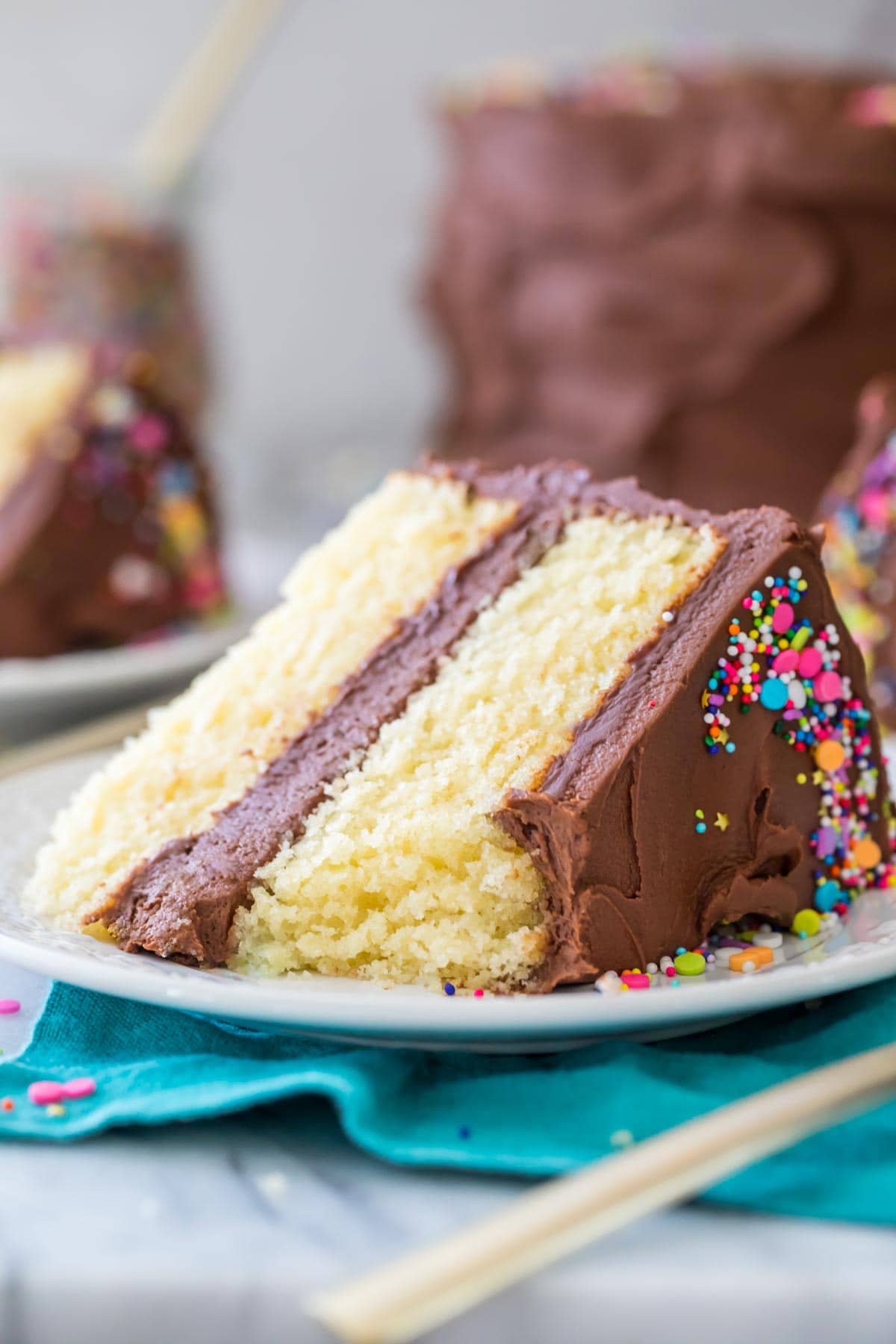
A Classic Vanilla Cake, Made Entirely From-Scratch
Every baker needs a solid vanilla cake recipe in their repertoire, and today’s recipe is just that.
It’s soft, plush, and perfectly moist. Not to be confused with my white cake, this recipe is a beautiful pale golden color and distinctly vanilla flavored. It pairs beautifully with any frosting, although a traditional chocolate frosting is my favorite finish!
Like my chocolate cake, this has been one of my most popular recipes for years (and you may recognize it as the base for both my pineapple upside-down cake and my marble cake). It’s a simple, classic, and incredible vanilla cake. So many of you have tried and loved this recipe, and while the recipe remains exactly the same, I thought it was about time for a facelift with new photos and a new video.
The flavor and texture of this cake is so much better than box-mix, and the preparation is almost as easy. I’ve included a few tips below to help you be successful, so make sure to read all the notes before you get started.
What You Need

After testing many versions and combinations of ingredients, I’ve found that a good vanilla cake needs the following ingredients:
- Oil AND butter. A blend of these two ingredients gives the cake the best possible flavor and texture. Butter provides flavor while oil adds moisture and keeps it from being too dry. A cake made with all oil would be moist but lacking in flavor, and an all-butter cake may have a more buttery taste, but would be more dry. Any neutral cooking oil will work here, but I typically recommend using either vegetable or canola oil. For the butter, unsalted is best so we have maximum control over the flavor of the cake
- Sugar. Plain granulated sugar works best. Brown sugar would add moisture, but would detract from the classic vanilla flavor and even weigh down the cake a bit.
- Eggs. You’ll need four eggs, and it’s best if you bring them to room temperature before adding them (this helps them incorporate into the batter more evenly).
- Vanilla. You can’t have vanilla cake without vanilla! I recommend using a good quality vanilla extract, so if you’ve got a batch of homemade vanilla extract, use it here!
- Flour. I developed this vanilla cake recipe to be work with all-purpose flour and that’s what I always use. However, you *could* use cake flour instead. To substitute by weight, you would use the same amount, but if you are using measuring cups you will need to substitute your flour properly.
- Baking powder. I know a tablespoon of baking powder may seem like a lot, but that’s not a typo. Always make sure your baking soda is fresh and avoid using a generic brand, which I’ve had mixed results with in the past.
- Salt. You can just use plain table salt.
- Buttermilk. I strongly recommend using full-fat buttermilk for the best flavor and texture. While I do have a buttermilk substitute, it doesn’t really make this vanilla cake quite as moist and flavorful as I like it to be, so now I strictly recommend using real buttermilk. And no, you do not *need* to have baking soda in a recipe in order to use buttermilk; we’re using it for its moisture and flavor here!
SAM’S TIP: One of the biggest mistakes you can make with this recipe is neglecting to measure your flour properly. If you over or under-measure your flour, your cake will not turn out right! Use the right method, be as precise as possible, and use a kitchen scale if you have one.
Remember, this is just an overview of the ingredients I used and why. For the full recipe please scroll down to the bottom of the post!
How to Make Vanilla Cake
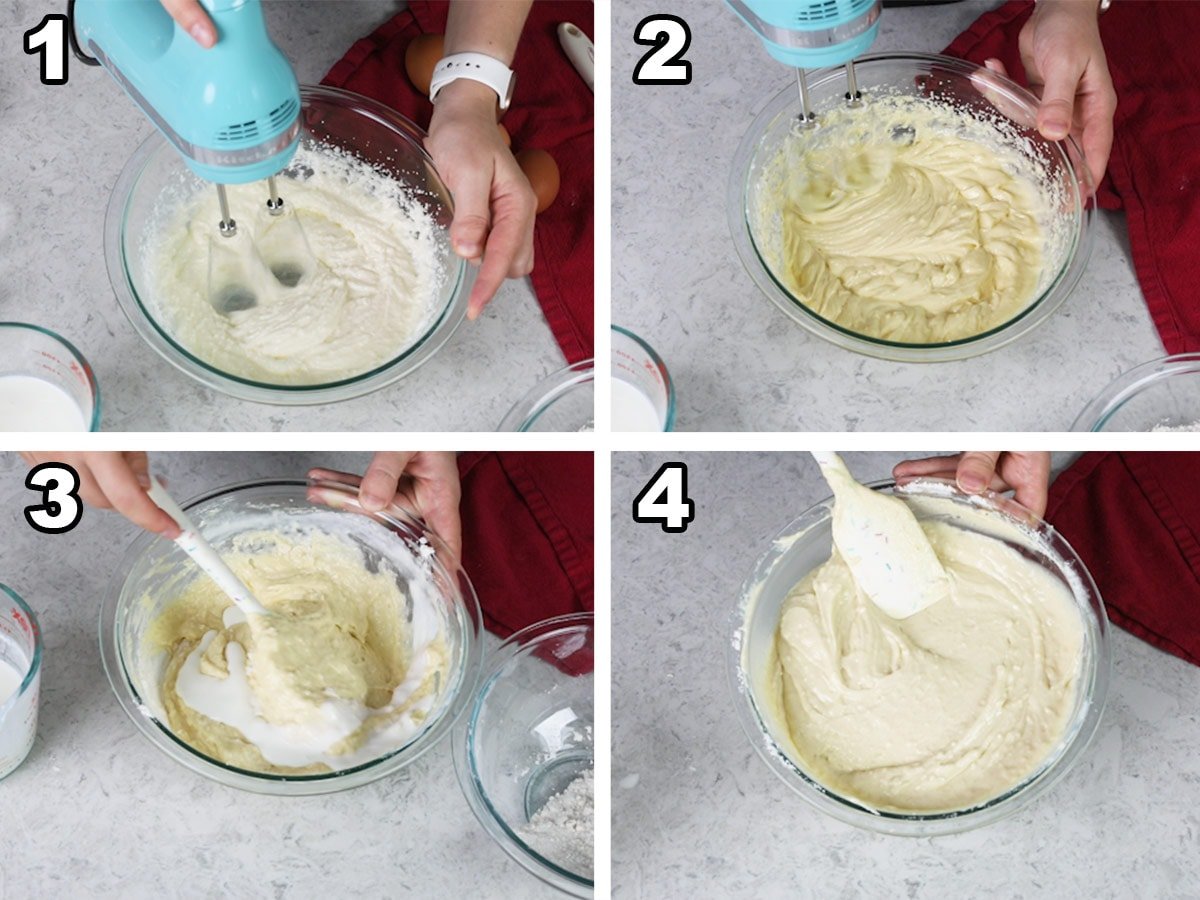
- Cream the butter, oil, and sugar in the bowl of a stand mixer.
- Add the eggs one at a time, beating well after each addition. Then, add your vanilla and stir to combine.
- Combine your dry ingredients in a separate bowl, then add about ⅓ of the mixture into your bowl. Use a spatula to gently stir until just combined. Follow this with about ½ of your buttermilk, and stir again until just combined. .
- Add ½ of the remaining dry ingredients stir, and then add the remainder of the buttermilk. Finish with the final portion of dry ingredients and use your spatula to make sure the batter is smooth–do NOT overmix!
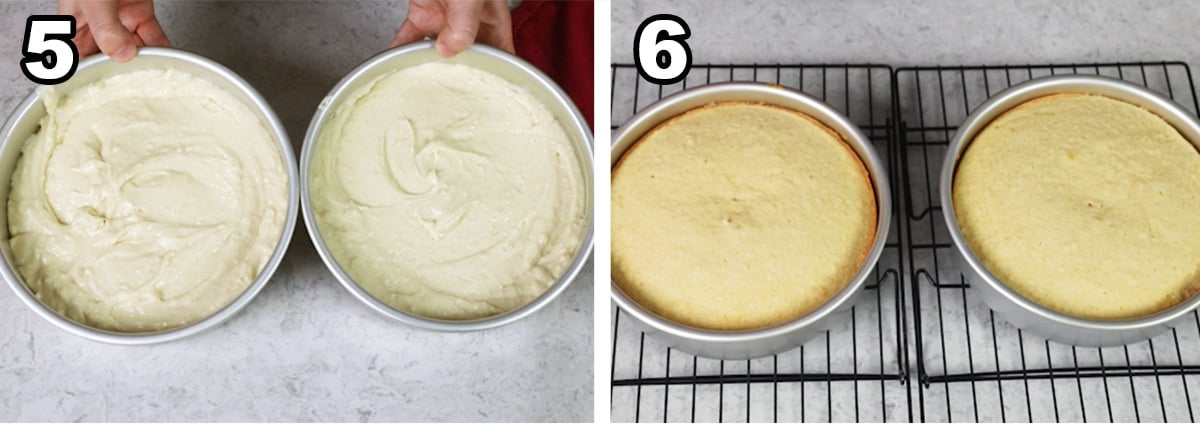
- Divide the batter evenly into two greased baking pans.
- Bake, then use a toothpick to test for doneness. Let the cakes cool in their pans a bit before inverting onto a cooling rack, where they’ll need to cool completely before frosting.
SAM’S TIP: While a toothpick that comes out clean indicates a fully baked cake, an over-baked cake will also yield a clean toothpick. It’s best to pull your vanilla cake out of the oven when a toothpick shows moist crumbs!
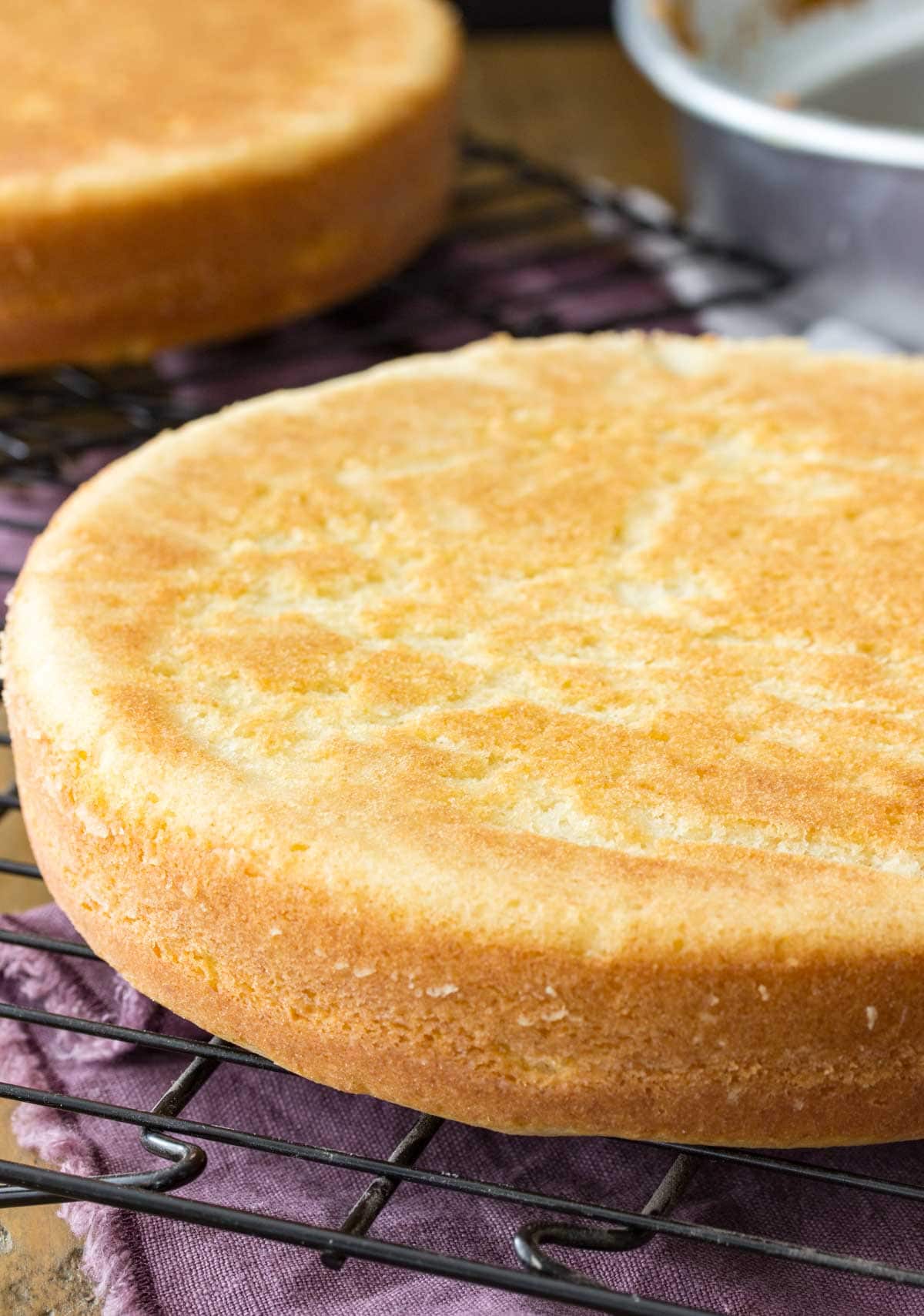
Frequently Asked Questions
Yes! This vanilla cake recipe will make 24 vanilla cupcakes. I’ve included instructions for cupcakes in the recipe notes.
A cake that has been over-baked or one in which too much flour was used will be crumbly when cut into. If you invert the cake too soon or try to handle it while it’s too warm, this could also make it break.
Cakes made from scratch require a bit more care and technique than those that come from a box-mix. When making any cake from scratch, take care to not over-mix, over-bake, or use too much flour, or the cake can end up tasting like cornbread. This applies to any cake that is made from scratch, not just this recipe!
What causes dry cake?
Dryness is typically the biggest complaint bakers have when making a cake from scratch, so I thought this FAQ deserved its own space. There are three main causes for a dry cake: over-measuring the flour (addressed above), over-mixing, and over-baking.
- Do not over-mix your batter! Mixing the batter properly can be tricky and this is often where most mistakes are made with homemade cakes. To avoid over-mixing, thoroughly cream together the wet ingredients, particularly the butter, sugar, oil, and eggs. I highly recommend using an electric mixer for this step! However, once you get to the point of combining your wet and dry ingredients, you need to be gentle and fold by hand using a spatula. Alternate adding the dry ingredients and the buttermilk, folding thoroughly, but not aggressively. The batter will be smooth and mostly cohesive; there may be some small lumps remaining, but that’s fine! Also, remember that while over-mixing can make your vanilla cake both dry and dense, under-mixing has its own risks and should be avoided as well!
- Do not over-bake your cake! Even a minute too long in the oven can cause a cake to be too dry and dense. When baking, place your cake pans on the center rack of your oven and always make sure your oven is running at the proper temperature (most ovens do not, so keep a thermometer in yours!). Don’t check your vanilla cake too early (that can make it sink!), but do keep an eye on it. When your cake is ready to come out of the oven, the center should spring back if lightly touched–it should not deflate or appear jiggly. You can also use the toothpick test to check for doneness. To do this, simply insert a toothpick in the center of your cake; it’s done if the toothpick comes out with a few moist crumbs (not wet batter). Once your vanilla cake is done, let it cool in the pan for only 10-15 minutes before running a knife around the edge and inverting it onto a cooling rack to cool completely.
SAM’S NOTE: Under-mixing your cake batter, not baking the cake for long enough, or opening the oven door too frequently while the cake bakes can cause the cake to sink as it cools.
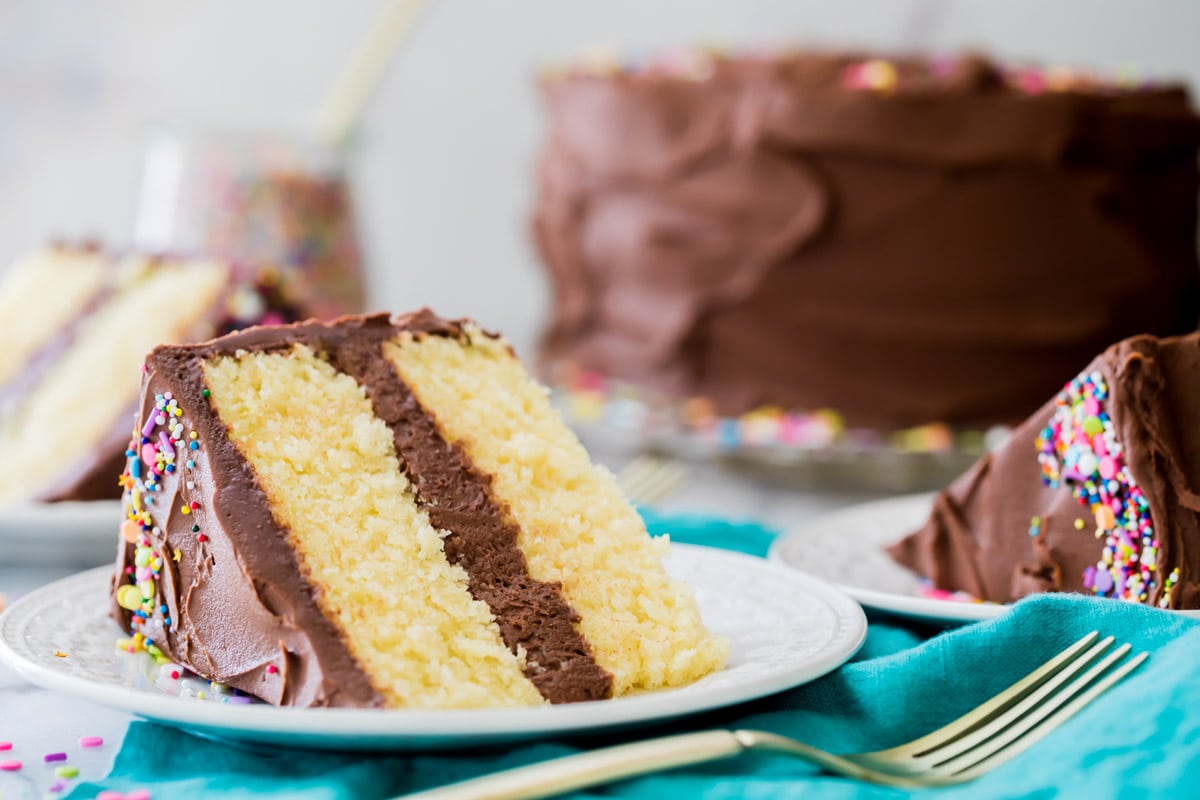
Enjoy!
Let’s bake together! I’ll be walking you through all the steps in my written recipe and video below! If you try this recipe, be sure to tag me on Instagram, and you can also find me on YouTube and Facebook
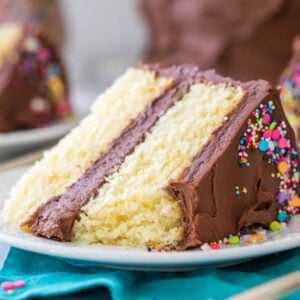
Vanilla Cake
Ingredients
- ½ cup (113 g) unsalted butter softened to room temperature
- ½ cup (120 ml) avocado, canola or vegetable oil¹
- 1 ½ cup (300 g) granulated sugar
- 4 large eggs room temperature preferred
- 1 Tablespoon vanilla extract
- 3 cups (375 g) all-purpose flour²
- 1 Tablespoon baking powder
- ½ teaspoon salt
- 1 ¼ cup (300 ml) buttermilk room temperature preferred
- 1 batch Chocolate Frosting click link for recipe, or use one of the other frostings recommended in the notes below
Recommended Equipment
Instructions
- Preheat oven to 350F (177C) and prepare two deep 8" round cake pans³ by lining the bottoms with parchment paper and lightly greasing the sides. Set aside.
- In the bowl of a stand mixer (or in a large bowl using an electric mixer) cream together the butter, canola oil and sugar until creamy and well-combined.½ cup (113 g) unsalted butter, ½ cup (120 ml) avocado, canola or vegetable oil¹, 1 ½ cup (300 g) granulated sugar
- Add eggs, one at a time, beating until thoroughly combined after each addition.4 large eggs
- Stir in vanilla extract.1 Tablespoon vanilla extract
- In a separate, medium-sized bowl, whisk together flour, baking powder, and salt.3 cups (375 g) all-purpose flour², 1 Tablespoon baking powder, ½ teaspoon salt
- Using a spatula and gently hand-mixing, alternate adding flour mixture and buttermilk to the butter mixture, starting and ending with flour mixture and mixing until just combined after each addition. The batter should be thoroughly combined, but there may be some small lumps in the batter and avoid over-mixing (and do not use your electric mixer or stand mixer for this step).1 ¼ cup (300 ml) buttermilk
- Evenly divide batter into your prepared cake pans, and bake on 350F (175C) for 30-35 minutes. When the cake is done, the surface should spring back to the touch and a toothpick inserted in the center should come out mostly clean with few moist crumbs (no wet batter).
- Allow cakes to cool in their cake pans for 10-15 minutes before inverting onto cooling rack to cool completely before frosting.
- Frost cake using my chocolate frosting (or see notes for other favorite frosting options) and decorate with sprinkles (if desired).1 batch Chocolate Frosting
Notes
¹Cooking oil
You may use any neutral cooking oil instead of vegetable or canola oil. I generally don’t recommend olive oil, which is heavier and has a distinct flavor that could affect the end taste result of your cake.²Cake Flour
You may substitute cake flour for all-purpose flour. Use 3 ⅓ cups or 375g of cake flour.³Different size baking pans
- 13×9″ pan: This recipe makes enough for one 13×9″ baking pan. Readers have reported the approximate bake time is 30 minutes.
- Two 9″ pans: Readers have reported this cake takes approximately 25 minutes to bake in 9″ pans.
- Bundt pan: Readers have reported this cake takes approximately 40-45 minutes to bake in a bundt pan
Vanilla Cupcakes:
This recipe will make approximately 24 vanilla cupcakes. Fill cupcake liners no more than ¾ of the way full. Bake on 350F for 17-18 minutes or until a toothpick inserted in the center comes out with a few moist crumbs or clean.Frosting Options
The chocolate frosting I linked to in the ingredients is my favorite pairing with this cake, but here are some other great options:Video note
In the video I mistakenly say to add more buttermilk than is necessary. The written recipe is correct with 1 ¼ cups of buttermilk.Nutrition
Nutritional information is based on third-party calculations and should be considered an estimate only. Actual nutritional content will vary based upon brands used, measuring methods, cooking method, portion sizes, and more.

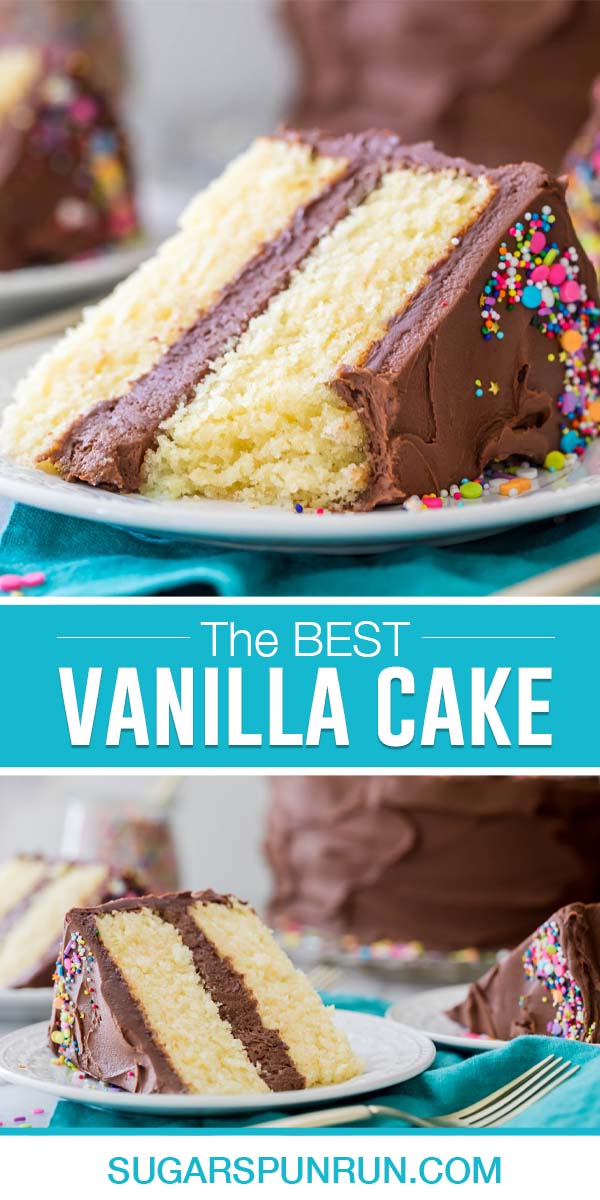
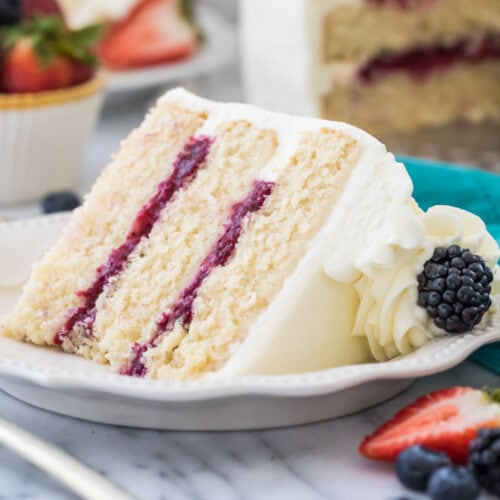
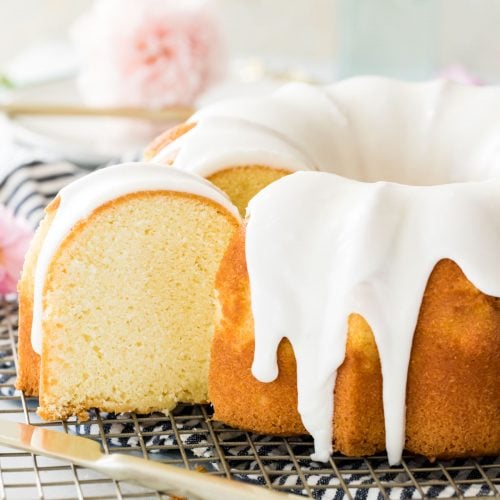
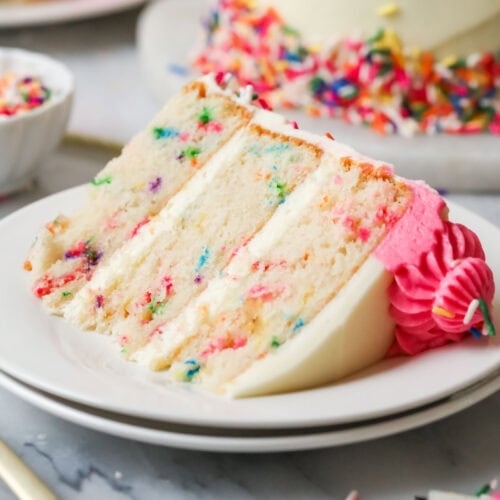
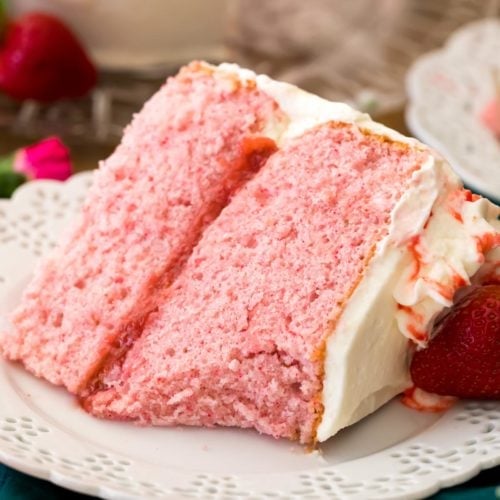
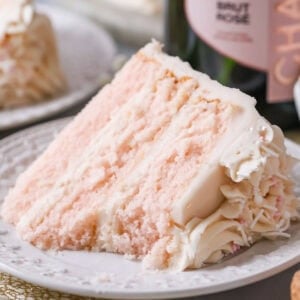
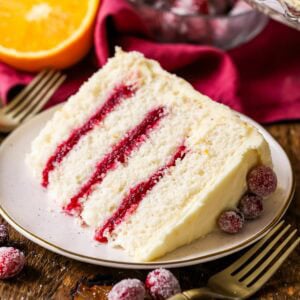

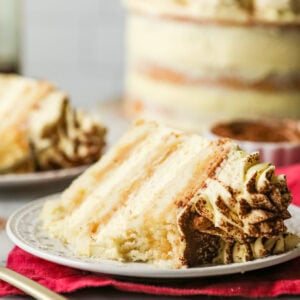
Nicole
Hello Sam, I reside in the UK. I love using your recipe for carrot cake and chocolate cake. I want to know if I can add food colouring to this cake to make it a marble cake please? Thank you for your time. Keep up the amazing work.
Sam Merritt
Hi Nicole! You can color the batter if you’d like. You will want to be careful not to over-mix the batter. I do have a true marble cake (Vanilla and chocolate mixed) if you are interested in that. 🙂
Adiva
I have had previous success with your cakes but I tried this one and after baking for 37 minutes it looked beautiful and the puffed up but I took it out and it immediately deflated and the middle was raw. I was so confused because I put a knife in it and it came out clean, any thoughts? I do everything in grams for accuracy and used spatula as suggested
Sam Merritt
I’m so sorry to hear this happened! Is it possible it was over-mixed a bit? Did you make any substitutions? Is it possible something may have been accidentally over-measured if it rose up like that?
Michelle
Dear Sam, thank you for your recipe, I used this recipe to make a number 60 cake and a large rectangular cake. Your recipe x 6 to feed 90 people! The cakes baked beautifully, perfect rise, good even crumb, moist, flavourful, easy to cut and stacked well. I followed your recipe exactly and did not change a thing. The cake was really tasty and moist when I tasted the cut off cake scraps of the number cake. However I had to refrigerate the cakes for the icing to set. Surprisingly, after refrigeration, the cake felt a bit dry even after thawing for a couple of hours. Do you think it’s because the butter hardened in the fridge? Would substituting oil instead of the butter solve this issue? Or should I have used simple syrup? Thanks once again for sharing your recipe, it’s a keeper and I will be using it again.
Sam Merritt
I’m so glad everyone ultimately enjoyed it, Michelle! That’s a lot of cake! I just want to check that you covered it during refrigeration? You could certainly brush it with a simple syrup if you run into this issue again. 🙂
Harley
Delicious as always!!! I really appreciate the inclusion of different times for different size pans and the cupcakes too. I appreciate all the time and effort you(all) put into these recipes🩵
Sarah
I absolutely love this recipe as is always delicious! I was just asked however for a lactose free vanilla cake, would it change anything if i use vegan butter and lactose free milk?
Sam Merritt
Hi Sarah! Unfortunately I have not tried using vegan butter or lactose free milk so I can’t say for sure how it would work. I believe others have done this with success. If you do try it, please let me know how it goes. 🙂
Sharon
I’ve been baking for many, many years but always struggle with cakes (too dry, sinking after removing from the oven). I check ingredients for freshness, make sure everything’s at room temp, follow all the rules. I was so happy yesterday with the results of this cake. It was the best I’ve ever made. I used it for a birthday cake and everyone loved it. Thank you!
Emily @ Sugar Spun Run
Yay! We are so happy to hear that, Sharon. Thanks for trying our recipe!
Raven
Can I just add sprinkles to this recipe to make it confetti style? And then use regular vanilla buttercream? The person I’m making it for does not like chocolate.
Emily @ Sugar Spun Run
Absolutely! We hope they love it 🙂
Lyn
I made this cake and everyone enjoyed it. It was more like a pound cake than a light vanilla cake. Very tasty
Emily @ Sugar Spun Run
We are so happy it was a hit, Lyn! Thanks for the review 🩷
CR
This is my favorite vanilla cake recipe. It has a great crumb and flavor.
Cindy
I am making this cake for my grandson’s first birthday. I did a “trial run” using this recipe and the buttercream icing recipe; everything was delicious. My only concern was that the cake was not soft enough to “smash” since I cooked the cake on one day and refrigerated overnight before making the icing and decorating it. Also, after I made the icing and decorated it on the second day, I then stored the cake in an airtight container in the refrigerator since the recipe has dairy (heavy cream) in it. So my questions are: (1) Should I bake the cake and ice it on the same day as the party? (2) Should I refrigerate the cake before icing it? and (3) Do I need to refrigerate the cake after icing it due to the dairy (heavy cream) in it? Any advice would be greatly appreciated!
Emily @ Sugar Spun Run
Hi Cindy! If you are using our buttercream frosting recipe, you shouldn’t need to refrigerate the frosted cake overnight; the large amount of sugar stabilizes the cream in the frosting for a day or two. If you want to prep the icing and cake layers in advance, everything can sit at room temperature in an airtight container (or just wrap the cake layers in plastic wrap). But letting the frosted cake sit at room temperature for a day or so beforehand might help soften it up a bit (as opposed to frosting day-of). Hope that is helpful!
Amanda
Can I make the cake and put icing on it the night before? Would I leave it at room temp?
Sam Merritt
Hi Amanda! This cake is fine to make and frost the night before. You can store it at room temperature in an air tight container. 🙂
Kristine
I’ve tried several different recipes of vanilla cake and this is the best I have tasted. I’ve used this recipe more than I can count. Moist and delicious. Thank you.
Doug
Will this recipe scale? In other words can I cut the amounts of the ingredients in half to make a smaller cake?
Sam Merritt
Hi Doug! You shouldn’t have any issues cutting this recipe in half. 🙂
Michelle F HOLMES
Great flavor and super easy to make. I used table sugar and whole milk (not a fan of buttermilk). I also used 9×13 glass baking dish. It took roughly 40 minutes to bake. Otherwise, it was moist, had great height and was very light. I also liked that it wasn’t as sweet.
Celeste
The flavor was good, but it was dry. Wouldn’t make it again.
Sam Merritt
I’m so sorry to hear this happened, Celeste! A dry cake is often the result of over-baking. Did you use the toothpick test to see if the cakes had finished? That toothpick should come out with a few moist crumbs. If it comes out completely clean you’ve likely gone too far. 🙁
Peggy McElroy
Hi Sam. Can you freeze the cakes for a week or two, then put it all together when needed.
Sam Merritt
That will work just fine. 🙂